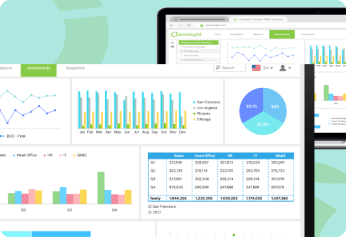Picture this: You're sitting in a boardroom, and someone asks about your company's financial position. Where do you turn? The balance sheet holds the answers. This financial snapshot reveals everything from cash reserves to outstanding debts, painting a complete picture of what your organization owns and owes at any given moment.
This glossary breaks down balance sheet analysis into digestible terms and concepts. Whether you're a finance professional looking to refresh your knowledge or a business leader seeking to better understand your company's financial health, you'll find practical insights that go beyond textbook definitions.
What is a Balance Sheet?
A balance sheet is a financial statement that provides a snapshot of a company's financial position at a specific point in time. Think of it as a financial photograph – it captures exactly what the company owns (assets), what it owes (liabilities), and what belongs to the owners (equity) on a particular date.
Unlike income statements that show performance over a period, balance sheets freeze time. They answer the fundamental question: "What is our financial standing right now?" This makes them essential for investors, creditors, and management teams who need to assess financial stability and make strategic decisions.
The balance sheet sits alongside the income statement and cash flow statement as one of the three core financial statements. While the income statement shows profitability and the cash flow statement tracks money movement, the balance sheet reveals the cumulative result of all business activities since the company's inception.
Key Components of a Balance Sheet
Assets
Assets represent everything of value that a company owns or controls. They're the resources that generate future economic benefits, from the cash in your bank account to the equipment in your warehouse.
Current Assets are resources expected to be converted to cash or used within one year. These include:
- Cash and cash equivalents
- Accounts receivable (money customers owe you)
- Inventory
- Prepaid expenses
- Short-term investments
Non-Current Assets (also called fixed or long-term assets) provide value over multiple years:
- Property, plant, and equipment (PPE)
- Intangible assets like patents and trademarks
- Long-term investments
- Goodwill
The distinction matters because current assets indicate your ability to meet short-term obligations, while non-current assets show your capacity for long-term growth and operations.
Liabilities
Liabilities are obligations – money or services you owe to others. They represent claims against your assets and must be settled in the future.
Current Liabilities are obligations due within one year:
- Accounts payable (money you owe suppliers)
- Short-term debt
- Accrued expenses (wages, taxes, utilities)
- Deferred revenue (payments received for future services)
Long-Term Liabilities extend beyond one year:
- Long-term debt (mortgages, bonds)
- Pension obligations
- Deferred tax liabilities
The timing of these obligations affects cash flow planning. High current liabilities relative to current assets might signal potential liquidity challenges, while manageable long-term debt can fund growth opportunities.
Equity
Equity represents the owners' residual interest in the company after all liabilities are paid. It's what would theoretically remain if you sold all assets and paid all debts.
Components of Equity include:
- Share Capital: Money invested by shareholders
- Retained Earnings: Accumulated profits kept in the business
- Additional Paid-in Capital: Amounts received above par value of shares
- Treasury Stock: Company's own shares bought back (shown as negative equity)
Equity grows through profitable operations and additional investments, while losses and dividend payments reduce it. A strong equity position provides financial cushion and flexibility for future investments.
The Balance Sheet Equation
The fundamental balance sheet equation is:
Assets = Liabilities + Equity
This equation must always balance – hence the name "balance sheet." It reflects the basic principle that everything a company owns (assets) is financed either by borrowing (liabilities) or owner investment and retained profits (equity).
Here's why this matters: If your assets total $500,000 and your liabilities are $300,000, your equity must be $200,000. This relationship helps verify the accuracy of your financial records and provides insight into your financing structure.
The equation can be rearranged to show:
- Equity = Assets - Liabilities (showing net worth)
- Assets - Liabilities = Equity (emphasizing the residual nature of equity)
How to Read a Balance Sheet
Step-by-Step Guide
Reading a balance sheet becomes straightforward when you follow a systematic approach:
Step 1: Start with the HeaderCheck the company name, statement title, and date. Remember, this represents a specific point in time, not a period.
Step 2: Review Asset Structure
- Look at current vs. non-current asset breakdown
- Identify the largest asset categories
- Note any unusual or significant items
Step 3: Analyze Liability Composition
- Compare current and long-term obligations
- Check debt levels relative to assets
- Look for any concerning liability trends
Step 4: Examine Equity Section
- Review retained earnings trends
- Check for recent equity changes
- Note any treasury stock or unusual equity items
Step 5: Verify the BalanceConfirm that Assets = Liabilities + Equity. Any discrepancy suggests errors in the financial data.
Step 6: Look for Red Flags
- Current liabilities exceeding current assets
- Declining equity over time
- Unusual asset concentrations
- Significant changes from previous periods
Balance Sheet Analysis: Methods and Importance
Why Analyze a Balance Sheet?
Balance sheet analysis reveals financial health indicators that aren't obvious from surface-level numbers. It helps answer critical questions:
- Can the company pay its bills?
- Is the business financially stable?
- How efficiently are assets being used?
- What's the company's growth potential?
- How much financial risk exists?
For finance teams drowning in spreadsheet analysis, proper balance sheet evaluation provides the foundation for strategic planning and risk management. It informs decisions about credit extensions, investment opportunities, and operational changes.
Types of Analysis
Vertical Analysis
Vertical analysis expresses each balance sheet item as a percentage of total assets. This technique helps identify the relative importance of different components and makes it easier to spot unusual concentrations.
For example:
- Cash might represent 15% of total assets
- Inventory could be 25% of total assets
- Long-term debt might equal 40% of total assets
This analysis reveals your company's asset allocation strategy and financing mix. A company with 60% of assets in inventory might face liquidity challenges, while one with 50% in cash might be missing growth opportunities.
Horizontal Analysis
Horizontal analysis compares balance sheet items across multiple time periods, typically showing dollar changes and percentage changes year-over-year.
Example horizontal analysis:
|
Item |
2023 |
2022 |
Change ($) |
Change (%) |
|
Cash |
$150,000 |
$100,000 |
$50,000 |
50% |
|
Inventory |
$200,000 |
$250,000 |
($50,000) |
(20%) |
|
Total Assets |
$500,000 |
$450,000 |
$50,000 |
11% |
This analysis helps identify trends, growth patterns, and potential problems. Rapid inventory growth might indicate slow sales, while declining cash could signal liquidity concerns.
Balance Sheet Examples
Sample Balance Sheet
Here's a simplified balance sheet for ABC Manufacturing Company as of December 31, 2023:
|
ASSETS |
Amount ($) |
|
Current Assets |
|
|
Cash |
75,000 |
|
Accounts Receivable |
125,000 |
|
Inventory |
200,000 |
|
Total Current Assets |
400,000 |
|
Non-Current Assets |
|
|
Equipment (net) |
300,000 |
|
Building (net) |
200,000 |
|
Total Non-Current Assets |
500,000 |
|
TOTAL ASSETS |
900,000 |
|
LIABILITIES & EQUITY |
Amount ($) |
|
Current Liabilities |
|
|
Accounts Payable |
100,000 |
|
Short-term Debt |
50,000 |
|
Total Current Liabilities |
150,000 |
|
Long-term Liabilities |
|
|
Long-term Debt |
250,000 |
|
Total Long-term Liabilities |
250,000 |
|
Total Liabilities |
400,000 |
|
Equity |
|
|
Share Capital |
200,000 |
|
Retained Earnings |
300,000 |
|
Total Equity |
500,000 |
|
TOTAL LIABILITIES & EQUITY |
900,000 |
Key Insights from This Example:
- Liquidity: Current ratio of 2.67 ($400,000 ÷ $150,000) suggests good short-term liquidity
- Leverage: Debt-to-equity ratio of 0.8 ($400,000 ÷ $500,000) indicates moderate leverage
- Asset Mix: 44% current assets, 56% non-current assets shows balanced asset allocation
- Financing: 56% equity-financed, 44% debt-financed demonstrates conservative financing
Limitations of the Balance Sheet
Understanding Limitations
While balance sheets provide valuable insights, they have several limitations that finance professionals must understand:
- Historical Cost Basis: Assets are typically recorded at historical cost, not current market value. Your building purchased for $200,000 five years ago might now be worth $350,000, but the balance sheet won't reflect this appreciation.
- Missing Intangible Assets: Many valuable assets don't appear on balance sheets. Your company's brand value, customer relationships, employee expertise, and internally developed intellectual property often aren't captured in the numbers.
- Point-in-Time Snapshot: Balance sheets show one moment in time. A company might look financially healthy on December 31st but face cash flow problems in January.
- Accounting Method Variations: Different accounting methods (FIFO vs. LIFO for inventory, straight-line vs. accelerated depreciation) can significantly impact balance sheet presentation.
- Off-Balance Sheet Items: Some obligations and assets might not appear on the balance sheet, such as operating leases, contingent liabilities, or certain financial instruments.
- No Performance Context: Balance sheets don't show how efficiently assets generate revenue or profits. A company with $1 million in assets generating $100,000 in profit performs differently than one generating $300,000 in profit with the same asset base.
To overcome these limitations, complement balance sheet analysis with income statements, cash flow statements, market data, and industry benchmarks. This comprehensive approach provides a more complete picture of financial health and performance.
Simplify Your Balance Sheet Analysis with Modern Tools
Balance sheet analysis doesn't have to be a time-consuming spreadsheet exercise. Finance teams today need reliable, real-time insights without the manual data consolidation and error-checking that traditional methods require.
Modern FP&A platforms can transform how you approach balance sheet analysis by centralizing data from your ERP systems, automating calculations, and providing intuitive dashboards that make financial insights accessible to your entire team. Instead of spending hours formatting spreadsheets, you can focus on strategic analysis and decision-making.
Ready to streamline your financial analysis process? Explore how Limelight can help your finance team move beyond spreadsheets to deliver faster, more reliable financial insights.
Table of Contents
Ready to put an end to outdated FP&A?
Get a perzonalized demo


